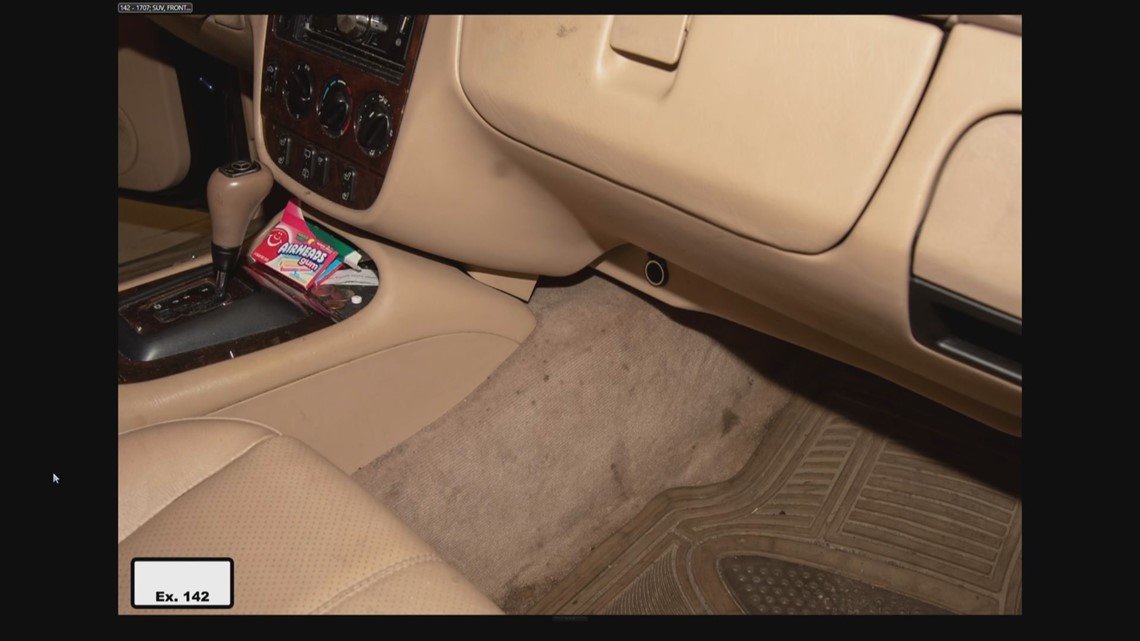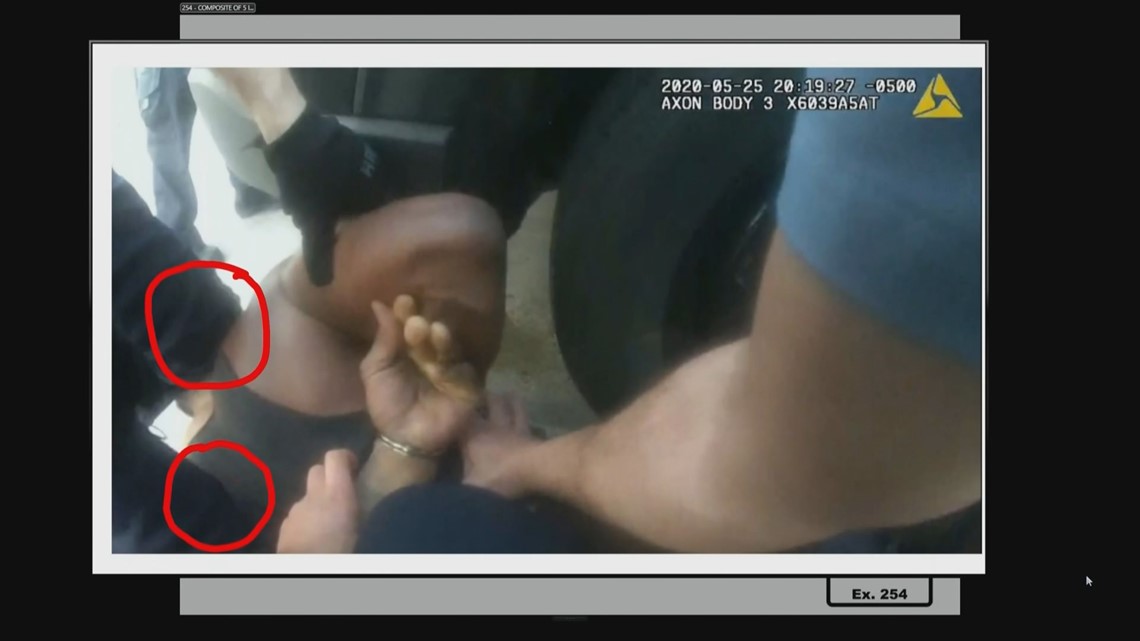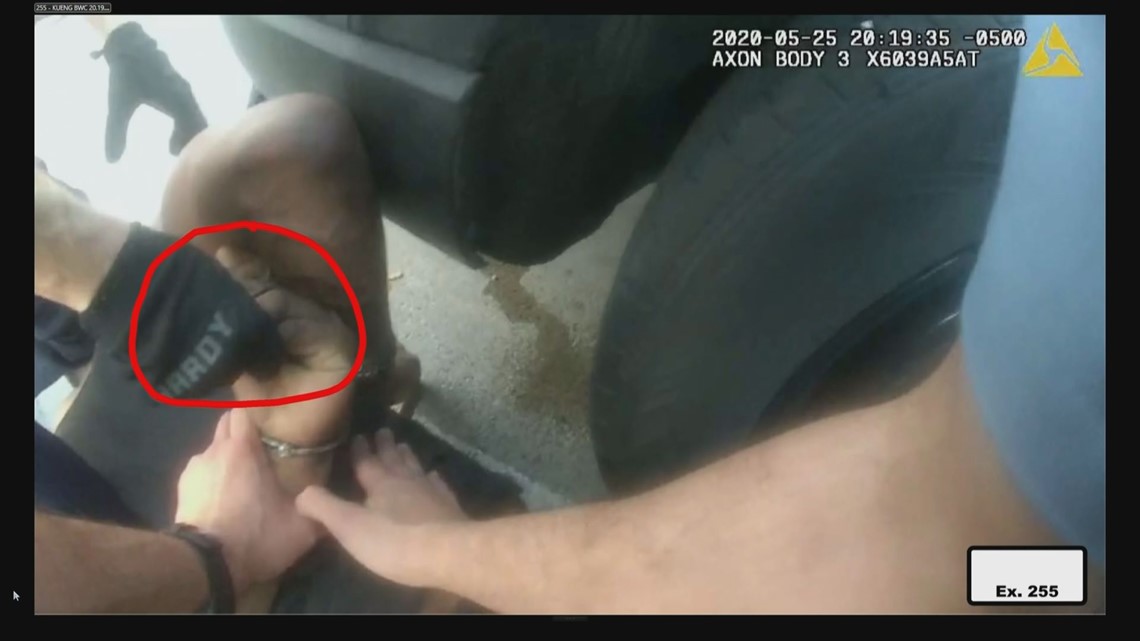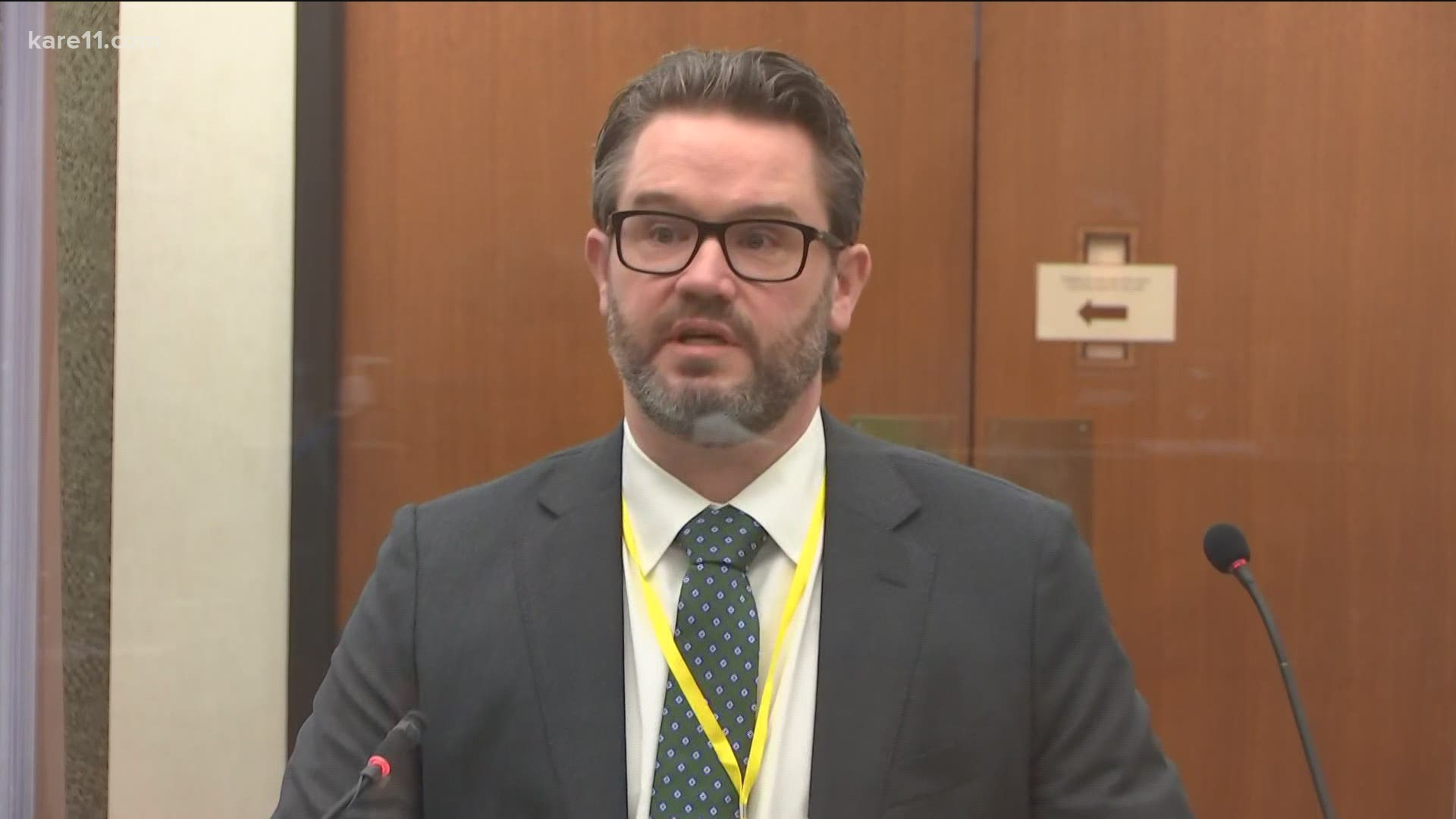MINNEAPOLIS — Editor's note: Some of the images depicted in the video and testimony are graphic. Have a question you'd like to hear our trial experts answer? Send it to lraguse@kare11.com or text it to 763-797-7215.
Wednesday, April 7
- Defense attorney suggests Floyd says 'I ate too many drugs' in body camera video
- After listening to longer video clip, BCA agent believes Floyd is saying 'I ain't do no drugs'
- LAPD sergeant takes the stand as an expert witness: 'No force should have been used once he was in that position.'
- Sgt. Stiger adds that 'positional asphyxia' is already deadly, and was compounded by the weight of three officers
- BCA agents questioned about drugs found in vehicles at scene, not found until second round of searches
- Forensic chemist says methamphetamine purity in pills was low
Former Minneapolis police officer Derek Chauvin's defense attorney introduced a new element to the trial on Wednesday, by suggesting that George Floyd said the words "I ate too many drugs" while being restrained.
Chauvin is charged with second-degree murder, second-degree manslaughter and third-degree murder in Floyd's death, after bystander and police body camera video showed him kneeling on Floyd's neck for more than 9 minutes.
Nelson played a short clip of the body camera video Wednesday for the state's expert witness on use of force, LAPD Sgt. Jody Stiger. Nelson asked Stiger to confirm that it sounded like Floyd said those words, and he said he could not make out what was said.
Nelson played the video again for the next witness, the lead BCA agent in charge of the investigation into Floyd's death. Special Agent James Reyerson agreed with the defense that it sounded like Floyd was saying "I ate too many drugs."
The prosecution called Reyerson back to the stand after a break and asked him to watch a longer video clip where the officers' preceding comments can be heard. Reyerson said in context, it sounds like Floyd is saying "I ain't do no drugs."
The official transcript of the video does not transcribe what Floyd said. Before that comment, the officers were discussing the fact that they believe Floyd is high, and that they found a pipe.
Attorney Lee Hutton, who is acting as a trial expert for KARE 11, said he was surprised that the prosecution did not object to the video. He said the incident was likely "a little scary" for the state.
The defense made a point of questioning Reyerson and BCA scientist McKenzie Anderson about the pills found in the Mercedes SUV Floyd was in before he was arrested, and in the squad car officers tried to detain him in. Drugs were not retrieved from the vehicles until a second search of each, one of which was prompted by the defense.
A forensic chemist also took the stand, saying that the fentanyl levels found in the pills were normal, but the methamphetamine levels were much lower than what she usually sees.
The jury heard all morning from Stiger, the state's expert witness on use of force who called Chauvin's use of force "excessive." He went on Wednesday to emphasize that the force Chauvin used was "deadly."
"At the time of the restraint period Mr. Floyd was not resisting, he was in the prone position, he was handcuffed, he was not attempting to evade, he was not attempting to resist, and the pressure that was being caused by the body weight could cause positional asphyxia, which could cause death," he said.
RELATED: 'Excessive' and 'deadly': What an LAPD sergeant testified about Derek Chauvin's use of force
LIVE UPDATES
Wednesday, April 7
4:30 p.m.
The prosecution called Susan Neith, a forensic chemist from NMS Labs, to the stand at the end of the day.
She performed testing on three pills sent to her from the BCA: two from the Mercedes (identified in court as item 48) and one from the squad car (item 51).
Prosecutor Erin Eldridge asked her to share the results of the tests. She said the tablets found in the Mercedes showed less than 1% fentanyl. One had 1.9% meth and one was 2% meth.
In the tablet from the squad, she said the fentanyl was less than 1% and the methamphetamine purity was 2.9%.
Neith said that level of fentanyl purity is common. However, she said, the methamphetamine levels were lower than she usually sees.
"Generally we see higher levels in methamphetamine samples that I have tested," she said. "Majority of the time I see 90 to 100% methamphetamine."
4:15 p.m.
A third Minnesota BCA agent took the stand on Wednesday, Breahna Giles.
She tested the pipe collected as evidence, along with the pills found in the vehicles. Giles said the tablets in the Mercedes SUV contained methamphetamine and fentanyl.
Then she tested pieces of pills found in the squad car, which she said contained meth. There were "indications of other substances" that were too small to meet the BCA threshold for measurement, Giles said. Upon cross-examination, she could not say whether those traces were fentanyl.
2:50 p.m.
Minnesota BCA scientist McKenzie Anderson was the third witness called by the prosecution on Wednesday.
She was part of the team that took over the investigation from Minneapolis police once George Floyd died on May 25, 2020. Anderson helped to process two vehicles from the scene: the Mercedes that Floyd was in before he was arrested, and the police squad where officers attempted to detain him.
She said her team takes photos to make sure everything is "thoroughly documented," and then someone else analyzes those photos.
Anderson said she knew there might be blood and money found during the search, but she was not looking for anything else specific. She said she did not have information that Floyd may have been under the influence.
Frank walked Anderson through photos taken of the Mercedes, including one that shows the center console.
"Next to the gum there is a small white pill," she said.


Anderson said she was asked to search the Mercedes a second time in December 2020, at the request of the attorney general's office. At that time, she was asked to collect "pills in the center console."
She was also told to recover Suboxone, which she described as a prescription medication used by adults with opioid addictions.
Anderson said she recovered two pills and the Suboxone after a second search.
When the defense later requested their own viewing of the squad car, they discovered a pill in the back seat. Anderson said she recovered that pill and other fragments during a second search.


The pill found in the squad was tested and found to have saliva on it. That saliva matched George Floyd's DNA profile, Anderson said.
Anderson also testified that blood was found in the squad car. The blood matched Floyd's DNA profile as well.
2:45 p.m.
The prosecution called BCA Special Agent James Reyerson back to the stand after a break Wednesday afternoon to address a video shown earlier.
The defense had asked Nelson if he thought Floyd was saying "I ate too many drugs" and he agreed. Prosecutor Matthew Frank played the video again, including the comments from officers leading up to Floyd's statement.
Frank asked Reyerson if he has a different opinion of what Floyd is saying now that he can hear the context.
"I believe Mr. Floyd is saying, 'I ain't do no drugs,'" Reyerson said.
1:50 p.m.
Defense attorney Eric Nelson cross-examined BCA agent James Reyerson, who led the investigation of the Minneapolis Police Department after George Floyd's death.
Reyerson confirmed that the BCA's investigation was "extensive." Nelson quickly moved to the topic of the two searches performed on the Mercedes and Minneapolis squad 320.
He confirmed that the defense requested to view the squad, which was in BCA custody. Reyerson confirmed that this is a common request, and that the squad was sealed until the defense was allowed to look at it. Nelson asked if Reyerson believed that the defense planted drugs in the squad, and he said no.
The BCA agent said of the 750 photos he reviewed of the car, he did not notice the pills after the first search.
"You weren't necessarily looking for something of that nature, correct?" Nelson asked. Reyerson said that was correct.
Nelson made a point of noting that the prosecution's case against Chauvin had already begun while the BCA was still investigating, which Reyerson acknowledged was "unusual."
Nelson asked Reyerson to view the same body camera clip he showed to the state's expert witness earlier in the day. He asked if it sounded like George Floyd said "I ate too many drugs." Reyerson said it did, while the earlier witness said he could not tell what Floyd was saying.
Upon redirect, prosecutor Matthew Frank asked Reyerson if that was the first time he'd been asked to interpret the video clip. He said yes. Frank also pointed out that Reyerson had not heard what the officers said before the short clip of Floyd.
Noon
The state called its second witness of the day after a full morning of hearing from an expert witness from the LAPD.
Minnesota Bureau of Criminal Apprehension Senior Special Agent James Reyerson took the stand at noon. He is assigned to a newly formed use-of-force investigation group.
Reyerson was called in to investigate Floyd's arrest and death once it was deemed a "critical incident" and handed over to the BCA. He said he seized two $20 bills from the police squad on the scene, along with a glass pipe.
Reyerson said the autopsy report showed that "Mr. Floyd may have been under some influence of some substance."
At that point, Reyerson said the prosecution asked for a re-processing of the Mercedes that Floyd was in on May 25, 2020 with a focus on finding any potential pills.
Later the defense requested a search of the squad car, and they identified a pill. Reyerson said after that, the squad car was also re-processed by the BCA.
9:50 a.m.
Defense attorney Eric Nelson cross-examined the state's expert witness, LAPD Sgt. Jody Stiger, on Wednesday morning.
Nelson asked Stiger if different police departments may rule differently on what use of force is appropriate.
Stiger responded that all departments he knows of judge use of force based on Graham vs. Connor, which he used to analyze Chauvin's actions. He did agree with Nelson that "reasonable minds can differ."
Nelson told the jury that Stiger's written report on Chauvin's use of force was 461 pages. He held up the stack of papers to demonstrate. Nelson pointed out that Stiger was given 5,737 pages of materials to review.
Stiger confirmed that the reasonableness of an officer's use of force is based not just on three prongs, but on the "totality of the circumstances." Nelson asked him to agree that sometimes the use of force is "instantaneous."
"Sometimes but not in this case, I don't believe so," Stiger said.
Stiger agreed that an officer needs to take into account "scene security," whether they are in a high-crime neighborhood, and whether there is traffic.
"Every single time an officer responds to a call, there is an inherent risk," Nelson said. Stiger agreed.
Nelson asked Stiger to confirm that use of force can't be evaluated in a vacuum.
"When I do my analysis I look at the totality of the circumstances, meaning I look at the officers' tactics, as well as the subject's actions during the whole entire incident," Stiger said.
Nelson pointed out that officers were responding to a call about a person who was more than 6 feet tall and possibly under the influence of drugs. He added that when Chauvin and Tou Thao were called, they were responding because backup was needed.
"It's reasonable for an officer to come in with a heightened sense of alertness or awareness," Nelson said.
"Absolutely," Stiger said.
Nelson asked if a handcuffed person could still present a threat, even after they are in the prone position.
"Based on that person's actions, yes," Stiger said.
Stiger added that the risk of kicking is the reason officers have the "hobble" device. The officers restraining Floyd discussed a hobble but never used one.
Nelson pointed out that the use of force can look bad without being excessive.
"Sometimes it may be caught on video, right? And it looks bad, right?" Nelson asked Stiger. "But it's still lawful." Stiger said yes, and added that he has done a presentation on that topic.
Nelson played a clip from the body camera video of Floyd being restrained, and asked Stiger if he could hear what Floyd was saying.
"Does it sound like he said, 'I ate too many drugs?'" Nelson asked.
"I can't make that out, no," Stiger said.
"So in the chaos of the situation things can be missed, right?" Nelson asked.
Attorney Lee Hutton, who is offering expert commentary on the trial for KARE 11, said he was surprised that the prosecution did not object to this.
"It's a highly prejudicial moment," he said. "You really don't know what George Floyd was actually saying, and I think that's a critical mistake."
The transcript of the body camera video did not include the words spoken by Floyd in that moment.
Nelson asked Stiger if suspects sometimes "catch their wind again" and resume fighting after being compliant.
Stiger said yes "in certain instances," but added, "in most cases officers are trained that you can only go by the suspect's actions at the time."
Nelson showed Stiger a slide from a "Phase 1 Defensive Tactics" training Chauvin took in March 2020. It said:
- Crowds are very dynamic creatures and can change rapidly
- Any crowd may contain elements of several different group types
- Non violent crowds may contain decoys to distract or deceive officers
Stiger pointed out that it was a training for "large crowds."
Nelson asked Stiger if a reasonable officer could perceive name-calling as a threat.
"Name-calling? I would say it depends on the officer's training and experience," Stiger said. He added that officers are typically trained that verbal threats alone do not justify force.
Nelson asked Stiger if his conclusion that the force was excessive and deadly was based on the supposition that Chauvin's knee was on Floyd's neck and pressing down on his carotid artery.
"Not necessarily on the carotid artery, but it was in the neck area and on the back," Stiger said.
Stiger confirmed that the phrase "control the head, control the body" is widely accepted by police.
Nelson asked Stiger about training materials that tell officers to use caution when removing handcuffs because "the subject may revive agitated and ready to fight."
Nelson also showed Stiger a surveillance photo of the scene that shows Chauvin's right shoulder lower than his left. Nelson asked if that indicates that Chauvin's weight is primarily on his right side, and Stiger said yes. Chauvin's right knee was on Floyd's back while his left knee was on his neck area.
The defense attorney asked Stiger to confirm that weight might shift from time to time. Nelson showed another photo and asked if Chauvin's knee appeared to be on the shoulder blades rather than the neck at that moment.
"It appears to be more above the shoulder blades," Stiger said. He commented that several of the photos and videos appeared to show the knee at the base of the neck.
Upon redirect, prosecutor Steve Schleicher asked Stiger to confirm that any pressure would increase the risk when someone is in a prone position, not just pressure on the neck.
"It's the pressure on the body," Stiger said. "Any additional pressure on the body complicates breathing more so than if there was no pressure at all."
Schleicher also confirmed with Stiger that a "Code 4" had been called once Chauvin arrived at the scene. That would mean that the suspect was in custody and the scene was secure.
Once an officer takes someone into custody, Stiger said, they have an "obligation" of care. He said the officer cannot just "opt not to believe" someone who says they are having a medical emergency.
"You have a responsibility to take some type of action," he said.
9:15 a.m.
LAPD Sgt. Jody Stiger resumed his testimony on Wednesday, as prosecutor Steve Schleicher continued his direct examination.
Stiger is an expert witness called by the state to evaluate Derek Chauvin's use of force against George Floyd. He testified on Tuesday afternoon that the force was "excessive."
Stiger said based on his review of body camera footage, the restraint lasted 9 minutes and 29 seconds.
Schleicher showed Stiger a series of photos, asking him to talk through his analysis of Chauvin's actions. Stiger circled Chauvin's knees on one body camera image, saying his left knee was on Floyd's neck and his right knee was on his back. Stiger said he believed Chauvin's weight was on his knees at this point.


Stiger said it also appeared that earlier Chauvin was attempting to use "pain compliance" on Floyd's hand. He pointed out another photo that showed Chauvin's hand holding Floyd's behind his back, saying it appears Chauvin is "squeezing" his fingers.
He said squeezing the fingers can cause pain, as can pulling the wrist into the handcuff. Stiger said this could cause pain especially because the handcuffs are double locked "they could continue to ratchet tighter as the person moved." He said he could hear the cuffs ratcheting in the body camera footage.
"What if there's no opportunity for compliance?" Schleicher asked.
"Then at that point it's just pain," Stiger said.
Stiger said Chauvin did not stop the pain compliance techniques during the restraint.


Stiger analyzed the use of force based on Graham vs. Connor, a U.S. Supreme Court case which has three prongs to determine the reasonableness of an officer's use of force. The first is the severity of the crime, which was a suspected counterfeit $20 bill. Stiger indicated that he viewed that as a low-level offense that would not normally require force.
The second is the presence of an immediate threat. Stiger said Floyd did not present an immediate threat to the officers, drawing partially on the fact that there were four officers present.
The third prong is whether the person is actively resisting or attempting to flee.
"Based on my analysis Mr. Floyd never, was not actively resisting at the time that he was in the prone position, nor did he communicate to them that he was attempting to resist or evade them," Stiger said.
After reviewing the Minneapolis Police Department's use-of-force continuum, Stiger said, "My opinion was that no force should have been used once he was in that position."
Stiger also stated his opinion that the restraint of Floyd shown on the video constitutes "deadly force."
"At the time of the restraint period Mr. Floyd was not resisting, he was in the prone position, he was handcuffed, he was not attempting to evade, he was not attempting to resist, and the pressure that was being caused by the body weight could cause positional asphyxia, which could cause death," he said.
Stiger said the dangers of positional asphyxia have been known to police officers for "at least 20 years."
Stiger added that positional asphyxia alone could cause death, and in this case it was compounded by the weight of three officers: Chauvin, Thomas Lane and J. Alexander Kueng.
"When you add body weight to that, then it just increases the risk of death," he said.
Stiger said he would define a "hostile crowd" as one where people are threatening or throwing things at police. He looked at a still image of the bystanders watching Floyd's restraint.
"I did not perceive them as being a threat," he said. "Because they were merely filming and they were, most of it was their concern for Mr. Floyd."
Tuesday, April 6
During a period set aside for pretrial motions Tuesday morning, Judge Peter Cahill heard from Morries Hall, who wants to invoke his Fifth Amendment right not to testify because it would cause him to self-incriminate. Hall was with Floyd when he was arrested outside Cup Foods on May 25, 2020. The judge said he will hold a second hearing to go through a narrow list of questions that he believes are admissible, instead of allowing Hall to avoid testifying completely.
Tuesday, the jury heard from Lt. Johnny Mercil, who was in charge of use-of-force training at the time of Floyd's arrest. Mercil said using a knee on a person's neck is not a trained MPD neck restraint, but "isn't unauthorized" when using force. He confirmed that once a person is handcuffed and under control, the technique would no longer be authorized.
Officer Nicole Mackenzie also testified Tuesday, saying that officers are trained to provide CPR "immediately" once a pulse cannot be found.
On Tuesday afternoon, Rev. Al Sharpton and civil rights attorney Ben Crump joined members of George Floyd's family and supporters for a prayer for justice outside the Hennepin County Government Center.
Sharpton said he prayed for strength -- both for Floyd's family and for people around the country.
"Dear God, we come standing in front of a building where a jury is listening to evidence," Sharpton began. "But you know, Lord, you hold the world in the palm of your hand, and we believe if we stand for what's right that you will give us justice."
Sharpton is the founder of the National Action Network, an organization that calls attention to issues like racism, police brutality and racial profiling. In his Tuesday prayer, he also spoke on the proposed George Floyd Justice in Policing Act and racism around the country.

